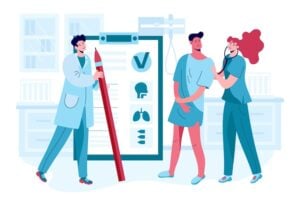Imagine developing a cutting-edge medical device, only to face a devastating recall. In 2017, Magellan Diagnostics’ LeadCare systems were pulled from the market after delivering inaccurate blood lead level readings, affecting over 7 million units. Similarly, Abbott’s defibrillators experienced premature battery depletion, jeopardizing patient safety for more than 175,000 people.
These are just two vivid examples that cost their companies millions of dollars and underscored the critical importance of thorough testing and robust safety measures. To help you avoid these pitfalls and drive healthcare innovation, our comprehensive 101 guide on medical device clinical trials offers actionable insights. We delve into the complexities of regulatory challenges, strategies to optimize trial efficiency, and leveraging technology to ensure your innovations are both safe and effective.
Ready to master the intricacies of medical device clinical trials and enhance your healthcare solutions? Let’s dive in.
Top Takeaways:
- Innovative Trial Designs: Embrace adaptive trial designs and personalized approaches to enhance patient outcomes and trial accuracy, making your medical device more competitive and effective.
- Boosting Trial Efficiency: Streamline processes by integrating automation and data-driven decision-making, significantly reducing administrative burdens and accelerating time-to-market for your medical device.
- Advanced Technology Integration: Leverage AI, machine learning, and remote patient monitoring to optimize data collection, enhance real-time analysis, and ensure robust compliance with regulatory standards.
Table of Contents:
- What is a Medical Device Trial?
- Benefits and Downsides of Medical Device Clinical Studies
- Understanding Medical Device Classifications
- What’s the Difference between Significant and Non-Significant Risk Devices?
- How Are Medical Device Clinical Trials Initiated?
- CROs and FSP Models in Medical Device Clinical Trials
- Types of Medical Device Clinical Trials
- FDA Requirements for Medical Devices
- Leveraging Technology in Clinical Trials
- Overcoming Challenges and Enhancing Efficiency in Medical Device Clinical Trials
- Navigating Key Challenges After a Clinical Trial
- Future Trends in Medical Device Clinical Trials
- How Topflight Can Help with Medical Device Clinical Trials
What is a Medical Device Trial?
Let’s start with the definition: A medical device clinical trial is a research study conducted to evaluate the safety and effectiveness of a medical device in human subjects. These trials are essential in gathering evidence that supports regulatory approval and market introduction.

The Evolving Landscape of Medical Device Innovation
Today, medical device clinical trials have become a cornerstone for innovation and advancement. These trials are pivotal in ensuring that new medical devices are both safe and effective before they reach the market.
Medical device innovation has come a long way, from rudimentary tools to sophisticated bio-medical devices designed to diagnose, treat, and monitor various health conditions (e.g., drug-eluting stents, insulin pumps, or wearable health monitors). With advancements in technology, the scope of medical devices has expanded significantly, encompassing everything from wearable health monitors to complex surgical instruments.
Global Distribution and Trends
- Regional Focus: As of 2022, North America leads in new medical device trial activity with 48%, followed by Europe at 30%, and Asia-Pacific at 16%. The top three countries for these trials are the United States, China, and Germany.
- Therapeutic Areas: Leading areas for new medical device trials include healthcare IT (14.7%), cardiovascular devices (14.3%), neurology devices (9.3%), orthopedic devices (7.5%), diagnostic imaging (7.1%), and anesthesia and respiratory devices (6.7%).
Market Growth and Trends
- Clinical Trials Market Size: The global clinical trials market is projected to grow from $61.58 billion in 2024 to $106.78 billion by 2032, with a CAGR of 7.1% during the forecast period.
- Number of Registered Trials: As of May 2023, there are 452,604 registered clinical trials globally, with 64,838 actively recruiting participants. Of these, 46,809 studies (around 10%) focus on medical devices.
This growth necessitates rigorous clinical investigation to establish safety and efficacy, adhering to stringent regulatory standards.
Importance of Clinical Trials in Healthcare Advancement
Clinical trials are not just a regulatory requirement; they are integral to the advancement of healthcare. They provide the necessary scientific evidence to support the use of new medical devices. By conducting comprehensive investigations, we can ensure that these devices meet the highest standards of safety and effectiveness. This process involves multiple stages, each meticulously designed to gather data and evaluate the device’s performance under various conditions.
Read more on software as a medical device (SAMD) clinical evaluation guide.
For decision-makers in healthcare enterprises, the importance of medical device clinical trials cannot be overstated. These trials help identify potential risks, refine device functionality, and ultimately improve patient outcomes. They also play a critical role in gaining FDA approval, a key milestone for any med device entering the market.
Key Objectives of Medical Device Clinical Trials
- Safety and Efficacy: To establish that the medical device is safe for human subjects and effective in its intended use.
- Compliance with Regulations: To ensure adherence to regulatory standards outlined by bodies such as the FDA.
- Data-Driven Insights: To gather robust data that can inform future improvements and innovations.
To better understand how integrating a clinical decision support system implementation can enhance the efficiency of your medical device, check out our detailed guide.
Benefits and Downsides of Medical Device Clinical Studies
Medical device clinical studies come with their own set of advantages and challenges that healthcare enterprises must navigate. Let’s dive into the key benefits and potential downsides of these essential investigations.

Advantages for Patients, Healthcare Providers, and Manufacturers
For Patients
- Improved Outcomes: Access to cutting-edge devices often results in better health outcomes.
- Human Subject Protection: Rigorous testing ensures high safety standards.
- Innovative Treatments: Trials offer access to new treatments and technologies.
For Healthcare Providers
- Evidence-Based Practices: Robust data enables informed decisions.
- Streamlined Workflows: Trials can lead to devices that improve efficiency.
- Professional Development: Participation offers learning opportunities.
For Manufacturers
- Market Approval: Successful trials enable market entry.
- Competitive Advantage: Demonstrating safety and efficacy differentiates from competitors.
- Regulatory Compliance: Trials assist in navigating regulatory pathways.
Potential Risks and Challenges
Costs and Resources
- High Costs: Trials require significant financial investment.
- Resource Allocation: Demand substantial resources, straining capacity.
Regulatory Hurdles
- Complex Regulations: Navigating stringent standards is daunting.
- Extended Timelines: Trials can delay time-to-market.
Operational Challenges
- Recruitment and Retention: Ensuring participant recruitment is challenging.
- Data Integrity: Managing trial data requires robust systems and meticulous attention.
If you’re grappling with the complexities of launching a health app alongside your medical device, our insights on the health app founders dilemma could provide valuable guidance.
Understanding Medical Device Classifications
Navigating the landscape of clinical trials for medical devices can be complex, particularly when considering the different classifications of devices and the specific requirements each class entails.

Class I, II, and III Devices: Key Differences
Medical devices are categorized into three classes based on their intended use and the level of risk they pose to patients:
- Class I Devices:
- Risk Level: Low risk
- Examples: Bandages, handheld surgical instruments, and examination gloves
- Regulatory Requirements: General controls, such as good manufacturing practices (GMP), labeling requirements, and device registration. Clinical trials are often not required.
- Class II Devices:
- Risk Level: Moderate risk
- Examples: Blood pressure monitors, infusion pumps, and surgical drapes
- Regulatory Requirements: General controls and special controls, which may include performance standards, post-market surveillance, and patient registries. Clinical trials may rarely be needed to demonstrate safety and efficacy, and when they are, Good Clinical Practice (GCP) guidelines should be followed.
- Class III Devices:
- Risk Level: High risk
- Examples: Pacemakers, implantable defibrillators, and heart valves
- Regulatory Requirements: Premarket approval (PMA) is required, which involves rigorous clinical trials conducted in compliance with Good Clinical Practice (GCP).
Impact on Clinical Trial Requirements
Understanding the classification of your medical device and its associated risk level dictates the types of clinical trials needed and the regulatory steps required to proceed. Here’s how classifications impact clinical trials for medical devices:
- Class I Devices: Generally exempt from clinical trials, allowing for a faster and less costly path to market.
- Class II Devices: May require clinical trials to gather data on performance and safety. These trials, while less extensive than those for Class III devices, still demand thorough planning and execution.
- Class III Devices: Demand the most rigorous clinical trials, including pilot studies, pivotal studies, and post-market studies. These comprehensive trials are designed to provide robust evidence of safety and efficacy, essential for obtaining premarket approval.
Explore how web3 development in healthcare is revolutionizing the industry and what this means for the future of medical devices.
What’s the Difference between Significant and Non-Significant Risk Devices?
When embarking on human trials, it’s essential to determine whether the investigational device is classified as a significant risk device or a non-significant risk device, as this affects the regulatory pathway and trial design.

- Significant Risk Device:
- Definition: A device that poses a potential for serious risk to the health, safety, or welfare of a subject.
- Examples: Implantable devices, life-supporting or life-sustaining devices, and devices used in diagnosing or treating diseases.
- Requirements: Requires an Investigational Device Exemption (IDE) from the FDA before starting human trials. This involves detailed submissions, including clinical trial protocols, informed consent documents, and ethical reviews by an institutional review board, such as the UCI IRB (Institutional Review Board at the University of California, Irvine). It’s a committee that oversees clinical trials and other research activities conducted under its jurisdiction to protect the rights and welfare of participants.
- Non-Significant Risk Device:
- Definition: A device that does not pose a significant risk to subjects.
- Examples: Dental plaque disclosing tablets, daily wear contact lenses, and most diagnostic devices.
- Requirements: Does not require IDE approval but must still adhere to IRB reviews and informed consent processes.
Implementing chatbots in healthcare could streamline patient communication and improve overall service efficiency.
How Are Medical Device Clinical Trials Initiated?
Initiating medical device trials is a multifaceted process that requires meticulous planning, thorough knowledge of regulatory requirements, and a clear understanding of the roles of all key stakeholders.

Key Stakeholders and Their Roles
Understanding the roles of various stakeholders can streamline the initiation process and ensure everyone is aligned with the trial objectives:
Sponsor
Usually the manufacturer or developer of the medical device. The sponsor is responsible for initiating, managing, and financing the trial. Sponsors can include:
- Pharmaceutical companies: Often have a large financial stake in the products being tested and may compensate scientists involved in the trials.
- Federal agencies: Such as the National Institutes of Health (NIH) and the U.S. Department of Veterans Affairs.
- Academic medical institutions: These can also be private sponsors.
- Individuals: Doctors or other healthcare providers.
Clinical Investigators
A researcher, often a doctor or other medical professional, who oversees the conduct of the trial, ensuring the use of the device complies with the trial protocol and regulatory requirements. Responsibilities include:
- Study design and execution
- Ensuring compliance with regulations and Good Clinical Practice (GCP)
- Overseeing study procedures and participant health
- Data analysis and reporting
- Reporting serious adverse events immediately
Clinical Research Coordinator
Handles various operational aspects such as:
- Participant recruitment and screening
- Trial coordination and data collection
- Report production and trial safety
- Material safety and regulatory compliance
- Patient health and progress tracking
Clinical Research Associate (CRA)
Manages and oversees clinical trials, involved in all stages from start to finish. Responsibilities include:
- Trial planning and setup
- Participant recruitment and monitoring
- Data collection and trial closeout
- Ensuring compliance with protocols and guidelines
Institutional Review Boards (IRBs)
Committees that review and approve the clinical trial protocols, informed consent documents, and monitor the study to protect the rights and welfare of participants.
Regulatory Authorities
Regulatory bodies like the FDA that evaluate the trial design to ensure it provides reasonable assurance of the device’s safety and effectiveness.
Timeline Expectations
Setting realistic timelines and efficiently allocating resources are critical steps in the initiation phase of medical device trials.
Preparation Phase
This includes designing the trial, preparing documentation, and obtaining approvals. Depending on the complexity and classification of the device, this phase can take several months to over a year.
- Class I Devices: Minimal regulation, typically approved through self-registration with the FDA. This process is relatively quick.
- Self-Registration Process:
- Step 1: Determine the device classification and applicable regulations.
- Step 2: Register the company and list the device with the FDA.
- Step 3: Implement and maintain quality management systems (QMS) as per FDA requirements.
- Self-Registration Process:
- Class II Devices: Requires substantial equivalence through the 510(k) process, taking around six months for approval. Clinical trials, if needed, can be short and last as little as one day.
- 510(k) Process:
- Step 1: Identify a predicate device already on the market.
- Step 2: Prepare a 510(k) submission, demonstrating that the new device is substantially equivalent to the predicate.
- Step 3: Submit the 510(k) to the FDA and wait for clearance before marketing the device.
- 510(k) Process:
- Class III Devices: Involves pre-market approval (PMA) with a focus on safety and efficacy through scientific evidence and trials. The PMA process averages eight months but can be longer for more complex devices.
Recruitment Phase
Enrolling participants, which can vary greatly depending on the target population and recruitment strategies. This phase can also span several months to years.
Execution Phase
Conducting the actual trial may range from several months to years, based on the complexity of the study and required follow-up periods. Overall, the entire process from initial preparation to final approval for the most complex cases can take anywhere from 3 to 7 years.

Resource Allocation
- Financial Resources: Budgeting for trial-related expenses, including personnel, technology, and participant compensation.
- Human Resources: Assembling a dedicated team with clear roles and responsibilities to manage the trial efficiently.
- Technological Resources: Implementing Electronic Data Capture (EDC) systems, telemedicine platforms, and other technologies to enhance data integrity and streamline trial processes.
Regulatory Considerations for Trial Initiation
Navigating regulatory requirements is a crucial aspect of initiating medical device trials. Here are key considerations to take into account:
- IDE Submission: For significant risk devices, an Investigational Device Exemption (IDE) must be submitted to the FDA. This includes detailed information about the trial design, risk assessment, and informed consent documents.
- IRB Approval: Regardless of the risk level, the trial protocol must be reviewed and approved by an IRB to ensure ethical standards are met.
- Pre-IND Meetings: Engaging in pre-IND (Investigational New Drug) meetings with the FDA can provide valuable guidance and clarity on regulatory expectations, potentially expediting the approval process.
- Compliance with GCP: Adhering to Good Clinical Practice (GCP) guidelines is essential for maintaining the integrity of the trial and ensuring participant safety.
If you’re considering developing a complementary app for your medical device, follow our 5 steps to build a healthcare app for a streamlined process.
Potential Issues with Class I and II Devices
Self-Registration
Maintaining compliance with FDA regulations is crucial for companies self-registering Class I and II devices. Continuous adherence to these standards is vital to avoid compliance issues and potential penalties. Staying updated with regulatory changes and adjusting company practices accordingly can also be challenging, requiring constant vigilance.
510(k) Process
The 510(k) process presents several challenges:
- Predicate Device Selection: Finding a sufficiently similar predicate device is often difficult. Mistakes in this step can lead to delays or rejections.
- Substantial Equivalence Demonstration: Proving substantial equivalence can be complex and resource-intensive, requiring thorough documentation and sometimes additional testing.
- Documentation and Testing: The submission process demands extensive paperwork, which can be time-consuming and costly.
- FDA Interactions: Miscommunications or misunderstandings with the FDA during the review process can cause significant delays.
Understanding and navigating these issues are essential for successfully bringing Class I and II medical devices to market while ensuring regulatory compliance.
Discover how leveraging AI through ChatGPT in healthcare can enhance patient interactions and support clinical decision-making.
CROs and FSP Models in Medical Device Clinical Trials
In the world of medical device clinical research, choosing the right model for conducting clinical trials can make a significant impact on efficiency, cost, and overall success.

Understanding Contract Research Organizations (CROs)
CROs are external organizations hired by medical device companies to plan, coordinate, and execute clinical trials. They offer a comprehensive range of services, from study design to regulatory submissions.
- Scope of Services: Full-service CROs handle everything from protocol development, site selection, patient recruitment, data management, statistical analysis, and final report preparation.
- Integration with Sponsor Processes: CROs typically integrate seamlessly with the sponsor’s existing processes, ensuring that the clinical trial aligns with the broader strategic goals.
- Control and Oversight: While CROs manage day-to-day operations, sponsors maintain oversight through regular updates and collaboration.
The cost of hiring a CRO for a medical device clinical trial is substantial, often running into millions of dollars. However, the exact amount will depend on the specific needs and scope of the trial, as well as its phase (phase 1: from $1m to $2m for CRO staffing services alone; phase 2: around $4m; phase 3: from $13m to $20m or more).
Here’s how much it would costs approximately to hire a CRO for orchestrating a 5-6-year medical device clinical trial:
| Services performed | Cost |
| Regulatory affairs | $65,000 |
| Site-related expenses | $2,294,000 |
| Medical device safety management and logistics | $86,000 |
| Biological sample and clinical supplies logistics | $100,000 |
| Medical writing | $25,000 |
| Project management | $1,000,000 |
| Study files/document management | $150,000 |
| Data management | $450,000 |
| Statistics | $150,000 |
| Quality control | $70,000 |
| Communication with central CRO/sponsor | $89,000 |
| Pass-through costs | $8,550,000 |
| Total Trial Budget | $13,029,000 |
What is the Challenge of Hiring a CRO?
Hiring a Contract Research Organization (CRO) presents several challenges, primarily the potential loss of direct control over day-to-day operations. This can lead to communication issues and misalignment of expectations between your team and the CRO, potentially impacting trial efficiency and outcomes.
Carefully vetting a CRO before hiring is crucial, especially given the lack of specific, niche marketplaces for CROs and Functional Service Providers (FSPs). Ensuring that the chosen CRO aligns with your business goals and maintains clear communication channels can help mitigate these risks and ensure the success of your clinical trials.
Understanding the cost of EHR implementation is crucial for integrating electronic health records with your new medical device.
The Functional Service Provider (FSP) Model Explained
The FSP model involves outsourcing specific functions, rather than the entire clinical trial, to specialized providers. This approach offers flexibility and allows sponsors to retain more control over the trial process.
- Scope of Services: FSPs provide targeted services such as data management, biostatistics, or regulatory submissions. This can be particularly useful for sponsors looking to fill gaps in expertise or capacity.
- Flexibility and Scalability: The FSP model is highly adaptable, allowing sponsors to scale services up or down based on trial needs.
- Knowledge Retention: Because only specific functions are outsourced, sponsors can retain more institutional knowledge and direct control over critical aspects of the trial.
CRO vs. FSP Models
Each model has its own set of advantages and limitations. Here’s a detailed comparison:
| CRO | FSP | |
| Scope of Services | Typically offers full-service solutions, managing entire studies or programs. This includes comprehensive end-to-end trial management, covering all aspects from study design to regulatory submissions. | Provides specialized services in specific functional areas such as data management, biostatistics, and medical writing. The focus is on targeted, function-specific services. |
| Integration with Sponsor Processes | Often works independently with less integration into the sponsor’s processes. While there is a high level of integration aligning with the sponsor’s overarching goals, day-to-day processes might operate more autonomously. | Usually integrates more closely with the sponsor’s team and processes, ensuring that specific functions are seamlessly aligned with the sponsor’s internal workflows. |
| Control and Oversight | Sponsors have less direct control over day-to-day operations but maintain oversight through regular updates and collaboration. | Sponsors retain more direct control and oversight of the work, allowing for closer monitoring and adjustments as needed. |
| Flexibility and Scalability | Less flexible once a contract is in place due to the comprehensive nature of the service agreement. | More flexible, allowing for scaling up or down of resources as needed based on the project’s demands. |
| Cost Structure | Often based on milestone payments or a fixed price for the entire project, which can be higher due to the full-service nature of their offerings. | Usually based on time and materials or full-time equivalent (FTE) pricing, making it more cost-effective for specific needs. |
| Knowledge Retention | There is a potential risk of losing institutional knowledge, as expertise and data often stay within the CRO. | Better knowledge retention within the sponsor organization due to closer integration and the targeted nature of the services provided. |
Pros and Cons: CRO vs. FSP vs. In-House Clinical Trials
CRO
- Pros: Comprehensive management, access to extensive expertise, reduced internal workload
- Cons: Higher costs, potential loss of control, possible communication challenges
FSP
- Pros: Flexibility, cost-effectiveness, better knowledge retention
- Cons: Limited scope, requires strong project management from the sponsor
In-House
- Pros: Full control, complete knowledge retention, internal team alignment
- Cons: High resource demand, potential lack of expertise, increased workload
Factors Influencing the Choice Between CRO and FSP Models
Several factors can influence whether a sponsor should choose a CRO or FSP model for their medical device clinical research:
- Trial Complexity: More complex trials may benefit from the comprehensive services of a CRO.
- Budget Constraints: Sponsors with limited budgets might prefer the cost-effective FSP model.
- Internal Expertise: Companies with strong internal capabilities may opt for FSPs to fill specific gaps.
- Timeline: Accelerated timelines might necessitate the broad expertise and resources of a CRO.
Types of Medical Device Clinical Trials
Here’s an in-depth overview of the different types of trials, highlighting their purposes and methodologies to help you navigate the complexities of the medical device clinical trial process.
Stages of Medical Device Clinical Trials
The medical device clinical trial process is divided into several key stages, each designed to achieve specific objectives and gather crucial data.
Preclinical Testing
Before clinical trials can begin, medical devices must undergo extensive preclinical testing to ensure safety and efficacy. This phase includes:
- Bench Testing
- Technical Testing
- Computer Simulations
- Animal Studies
These tests aim to ensure the device’s safety and efficacy before it is used in human trials.
Pilot Studies
These initial studies aim to assess the feasibility and gather preliminary data on the device’s performance. Researchers design pilot studies to identify potential issues before proceeding to larger trials.
- Objectives: Feasibility assessment, preliminary data collection
- Study Intervention: Initial use of the device in a small group to test feasibility
- Design: Flexible protocols, small sample sizes
- Outcomes: Early data on safety, usability, and potential efficacy
- Duration: Typically a few months to a year
Pivotal Studies
These are larger, more definitive trials intended to provide robust evidence of the device’s safety and efficacy. A pivotal study often involves randomized controlled trials (RCTs) to compare the new device with current standard treatments or a placebo.
- Objectives: Demonstrate safety and efficacy
- Study Intervention: Larger-scale testing to provide definitive evidence
- Design: Randomized controlled trials (RCTs), large sample sizes
- Outcomes: Robust data on safety and efficacy, regulatory submission
- Duration: Several years, depending on the complexity and follow-up requirements
Post-Market Studies
Once the device gains FDA approval, post-market studies monitor its long-term effectiveness and safety in the general population. These studies help identify any rare side effects and ensure ongoing compliance with regulatory standards.
- Objectives: Long-term monitoring, real-world evidence collection
- Study Intervention: Monitoring real-world use to gather long-term safety and efficacy data
- Design: Observational studies, real-world evidence collection
- Outcomes: Ongoing safety monitoring, regulatory compliance
- Duration: Ongoing, as required by regulatory authorities
Decentralized and Virtual Clinical Trials
Advancements in technology have introduced decentralized and virtual clinical trials as viable alternatives to traditional methods, offering significant benefits in terms of efficiency and participant convenience.
- Decentralized Trials: These trials leverage technology to conduct parts of the study remotely, reducing the need for participants to travel to study sites. This approach can enhance participant convenience and improve recruitment rates.
- Methodology: Remote data collection, telemedicine consultations
- Benefits: Increased participant diversity, reduced travel-related dropout rates
- Virtual Clinical Trials: Entirely conducted online, virtual trials use digital tools like telemedicine, mobile health apps, and electronic health records to collect data. This model can significantly reduce costs and expedite the research process while maintaining data accuracy and integrity.
- Methodology: Digital data collection, remote monitoring
- Benefits: Lower costs, faster timelines, enhanced data integrity
Running a Clinical Trial for a Class II Medical Device
To run a clinical trial for a Class II medical device, follow these key steps to ensure a smooth and compliant process:
- Develop a clinical trial protocol:
- Define study objectives
- Outline the study design
- Specify inclusion/exclusion criteria
- Determine sample size
- Plan data collection and analysis methods
- Obtain institutional review board (IRB) approval:
- Submit your protocol for ethical review
- Address any concerns raised by the IRB
- Register the trial:
- List your study on ClinicalTrials.gov
- Obtain investigational device exemption (IDE) if required:
- Some Class II devices may need an IDE from the FDA
- Recruit and train investigators and study sites
- Enroll participants:
- Screen potential subjects
- Obtain informed consent
- Conduct the study:
- Follow Good Clinical Practice (GCP) guidelines
- Monitor safety and efficacy
- Collect and manage data
- Analyze results and prepare reports
- Submit findings to the FDA if seeking marketing approval
By understanding these types and stages of clinical trials, decision-makers can better plan and execute their medical device clinical trial process, ensuring that they meet regulatory requirements while optimizing resource allocation and improving critical KPIs.
FDA Requirements for Medical Devices
Understanding the FDA requirements can make or break your trial’s success. This section provides an overview of the approval processes and offers strategies for efficient regulatory compliance.
510(k) vs. Pre-Market Approval (PMA)
Understanding the differences between the 510(k) and PMA processes is crucial for strategizing your clinical trials in medical devices.
510(k) Submission
- Purpose: Demonstrates that the new device is substantially equivalent to a legally marketed device not subject to PMA.
- Duration: Generally takes around six months.
- Requirements: Requires less data than PMA; often does not need clinical trial data unless the device significantly differs from existing ones.
Pre Market Approval (PMA)
- Purpose: Provides valid scientific evidence that the device is safe and effective.
- Duration: The process can take several months to years, depending on the complexity of the device and the data required.
- Requirements: Involves extensive clinical data, including results from pivotal studies, to demonstrate safety and efficacy.
Strategies for Efficient Regulatory Compliance
Regulatory compliance can be time-consuming and resource-intensive. However, adopting certain strategies can streamline the process and enhance efficiency.
Early Engagement with the FDA
Initiate discussions with the FDA early in the medical device software development process. Pre-submission meetings can provide valuable feedback on your clinical trial design and regulatory strategy.
Robust Clinical Trial Design
Ensure your clinical trial design meets FDA requirements. Incorporate input from regulatory experts and experienced researchers to address potential issues proactively.
Comprehensive Data Management
Implement robust data management practices to ensure data integrity and traceability. Utilize Electronic Data Capture (EDC) systems to streamline data collection and reporting.
Leveraging Technology in Clinical Trials
The integration of advanced technologies into the medical devices used in clinical trials offers substantial opportunities to streamline processes, enhance data integrity, and improve patient outcomes.
Role of AI and Machine Learning in Trial Optimization
Artificial Intelligence (AI) and machine learning are transforming the landscape of clinical trials by enabling more efficient and accurate data analysis. Here’s how:
- Predictive Analytics: AI algorithms can predict patient outcomes and identify potential risks, allowing researchers to make data-driven decisions throughout the study.
- Patient Recruitment and Retention: Machine learning models can analyze vast amounts of data to identify and recruit suitable participants more efficiently. These models help in retaining participants by predicting dropouts and intervening preemptively.
- Data Monitoring and Management: AI facilitates real-time monitoring of trial data to ensure compliance and detect anomalies. This helps in maintaining the integrity and accuracy of the collected data.
Electronic Data Capture (EDC) Systems: Enhancing Data Integrity
An Electronic Data Capture (EDC) system is a pivotal tool in modern clinical trials. EDC systems electronically collect, manage, and store clinical research data, offering several benefits:
- Efficient Data Collection: EDC systems streamline the data collection process by using electronic Case Report Forms (eCRF). This reduces manual entry errors and enhances data accuracy.
- Real-Time Data Access: Researchers have instant access to research data, allowing for better monitoring and faster decision-making.
- Compliance and Audit Trail: EDC systems provide a complete audit trail, ensuring compliance with regulatory requirements and making it easier to conduct audits.
Telemedicine and Remote Patient Monitoring in Clinical Trials
The advent of telemedicine and remote patient monitoring technologies has revolutionized how clinical trials are conducted, making them more patient-centric and efficient.
- Remote Data Collection: With 70% of clinical study data coming from connected devices, remote data collection is becoming increasingly crucial. Devices such as wearables and home monitoring equipment collect real-time health metrics, easing the burden on patients who would otherwise need frequent site visits.
- Patient-Centric Approach: Telemedicine facilitates virtual consultations, reducing the need for patients to travel to study sites. This not only saves costs but also improves patient retention by making participation more convenient.
- Improved Patient Interaction: The ability to interact remotely with patients ensures continuous monitoring and timely interventions, which can lead to better outcomes.
For those interested in how telemedicine can complement their medical device, our list of the best telemedicine apps offers a great starting point.
Practical Implementation Tips
- Choosing the Right Technology: Evaluate the specific needs of your clinical trial to select the appropriate technologies. Factors like the type of data being collected, the complexity of the trial, and participant accessibility should guide your choice.
- Training and Support: Ensure that your team and study sites are well-trained to use the new systems. Providing ongoing support can reduce the learning curve and minimize disruptions.
- Integration with Existing Systems: Integrate new technologies with existing systems to create a seamless workflow. This minimizes redundancy and maximizes efficiency. Medical data integration engines like Mirth Connect will come in handy.
Navigating the complexities of SaMD certification is essential for software as a medical device, ensuring compliance and safety.
Overcoming Challenges and Enhancing Efficiency in Medical Device Clinical Trials
Navigating the complex landscape of clinical trial requirements for medical devices involves addressing multiple challenges to optimize resource allocation, enhance operational efficiency, and ensure data quality and integrity.
Optimizing Resource Allocation and ROI
Balancing Innovation with Budget Constraints
- Prioritize Key Innovations: Focus on technological advancements like AI-driven data analysis and remote monitoring solutions.
- Utilize Cost-Effective Tools: Implement scalable Electronic Data Capture (EDC) systems.
- Leverage Grants and Partnerships: Seek grants and establish partnerships with academic institutions for cost-sharing opportunities.
Strategies for Reducing Time-to-Market
- Accelerate Regulatory Submissions: Utilize pre-submission meetings with regulatory bodies.
- Streamline Processes: Implement project management software tailored to clinical trials.
- Adopt Agile Methodologies: Use agile project management techniques for iterative improvements. Work with a healthcare app developer with proven expertise in the niche.
Measuring and Improving IT ROI in Clinical Trials
- Track Key Metrics: Monitor metrics such as time-to-market, cost savings from automation, and improved patient outcomes.
- Conduct Post-Trial Analysis: Perform thorough analyses to identify impactful IT investments.
- Continuous Improvement: Regularly update technology stacks based on feedback and performance data.
Enhancing Operational Efficiency
Streamlining Trial Processes through Automation
- Automate Data Entry: Use EDC systems for data entry and validation.
- Implement Robotic Process Automation (RPA): Handle repetitive tasks like scheduling and report generation.
- Standardize Workflows: Develop standardized workflows for consistency across trial phases.
Reducing Administrative Burden on Medical Staff
- Simplify Documentation: Use user-friendly electronic documentation systems.
- Delegate Non-Core Tasks: Outsource or delegate non-core administrative tasks.
Fostering Effective Communication
- Regular Meetings: Schedule regular meetings to discuss progress and align on objectives.
- Centralized Platforms: Use centralized communication platforms for updates and feedback.
Ensuring Data Quality and Integrity
Implementing Robust Data Management Practices
- Data Governance Framework: Establish data standards, roles, and responsibilities.
- Secure Data Storage: Use compliant storage solutions with regular audits and encryption protocols.
Leveraging Analytics for Real-Time Insights
- Real-Time Monitoring: Use real-time data monitoring tools.
- Predictive Analytics: Employ predictive analytics to forecast outcomes and optimize trial design.
By addressing these key areas, you can navigate the clinical trial requirements for medical devices effectively, ensuring successful outcomes while optimizing resources and enhancing operational efficiency.
Effective medical device integration is key to ensuring that your device works seamlessly within existing healthcare systems.
Navigating Key Challenges After a Clinical Trial
Completing a clinical trial is just one milestone on the path to market for Class II medical devices. Post-trial, companies face several critical challenges that must be addressed to ensure a successful product launch.
Reimbursement Strategy
Securing reimbursement from insurance providers and Medicare/Medicaid is a significant hurdle. Demonstrating the device’s cost-effectiveness and clinical benefits is essential to obtain favorable coverage and coding decisions. Physicians often inquire about:
- Insurance Billing: Understanding the insurance classification and reimbursement codes is vital. Researching CPT codes and consulting with insurance providers ensures the device is profitable.
- Revenue Generation: Providers need assurance that the device will generate sufficient revenue to justify its use. Knowing the reimbursement rates associated with these codes helps in making informed decisions.
Manufacturing Scale-Up
Transitioning from clinical trial production to full-scale manufacturing involves maintaining stringent quality control standards, meeting regulatory requirements, and managing production costs effectively. This phase demands meticulous planning and robust processes to ensure consistent product quality and compliance.
Market Adoption
Convincing healthcare providers to adopt the new device requires a comprehensive marketing strategy, extensive education, and clear evidence of clinical superiority or cost savings compared to existing solutions. Physicians often consider:
- Workflow Integration: Assessing how the device fits into current clinical processes is crucial. Thorough planning and training are needed to ensure smooth integration.
- Cost vs. Benefit: Evaluating whether the additional revenue justifies the implementation effort is essential. Piloting the device to understand its impact on workflow and patient care can provide valuable insights.
Post-Market Surveillance
Implementing systems for ongoing monitoring of the device’s performance in the market is crucial. Effective post-market surveillance helps detect and address any adverse events or issues promptly, ensuring patient safety and maintaining regulatory compliance.
By anticipating and proactively addressing these obstacles, Class II medical device companies can significantly improve their chances of a successful market launch.
Read more on medical device cost breakdown
Future Trends in Medical Device Clinical Trials
As we look towards the future, several trends are emerging that promise to revolutionize medical device clinical trials. Let’s focus on three key areas: personalized medicine, emerging technologies, and evolving regulatory landscapes.
Personalized Medicine and Its Impact on Trial Design
Personalized medicine tailors treatments to individual genetic profiles, lifestyles, and environments, improving outcomes and minimizing side effects.
- Customized Trial Protocols: Adaptive protocols in cardiovascular trials reduced adverse events by 30% and increased efficacy by 20%.
- Biomarker Utilization: Biomarkers in diabetes device trials resulted in more robust data and quicker regulatory approval.
- Patient Stratification: Segmenting patients based on characteristics identifies differential responses, leading to personalized treatments.
Emerging Technologies Shaping Clinical Research
Technology plays a pivotal role in advancing clinical research in medical device trials.
- AI and Machine Learning: AI optimizes data analysis, patient recruitment, and monitoring, enhancing trial designs and efficiency.
- Wearables and Remote Monitoring Devices: Wearables increase patient retention by 40% and improve data accuracy by 35%.
- Blockchain for Data Security: Blockchain ensures data integrity and transparency, maintaining stakeholder trust and regulatory compliance.
Learn how wearable technology in healthcare can be integrated with your medical device to provide comprehensive patient monitoring.
Adapting to Evolving Regulatory Landscapes
Staying ahead of regulatory changes is crucial for success in medical device trials.
- Regulatory Harmonization: Harmonized guidelines streamline approvals and market access.
- Real-World Evidence (RWE): Incorporating RWE strengthens trial findings and supports regulatory approval.
- Patient-Centric Regulations: New regulations emphasize patient engagement and feedback, requiring adaptable trial design and execution.
How Topflight Can Help with Medical Device Clinical Trials
At Topflight, we understand the unique challenges faced by decision-makers in medical device clinical trials. Our expertise in healthcare software development is demonstrated through successful collaborations with leading institutions and companies.
Ensuring Compliance and Data Security
We developed a HIPAA-compliant custom dashboard for a study with Medable and Stanford University School of Medicine. The app visualizes data from wearable devices tracking participants’ heart rates.
- HIPAA Compliance: Strict adherence to regulations ensures data security and patient privacy.
- Cross-Platform Integration: Seamless integration with iOS and Android ecosystems.
Enhancing Real-Time Data Visualization and Analysis
We designed a dashboard for real-time visualization of clinical trial data for a Fortune 100 pharmaceutical company, using IoT devices like smart flowmeters and smart pillboxes.
- IoT Integration: Smart devices for real-time data collection and analysis.
- Data-Driven Insights: Empowering trial managers with actionable data for quick decisions.
Facilitating Patient Engagement and Data Accuracy
For Solve ME, we developed a patient registry and symptom tracking app, allowing patients to self-report symptoms and participate in research studies.
- Patient-Centric Design: User-friendly interface encouraging participation and accurate reporting.
- Real-Time Data Collection: Immediate access to patient-reported data enhances research quality.
Our commitment to excellence in medical device clinical trial design ensures that your trials are efficient, compliant, and impactful. Ready to take your clinical trials to the next level? Schedule a consultation with one of our experts today.
Frequently Asked Questions
How can software streamline the management of medical device clinical trials?
Our custom solutions automate data collection, enhance real-time monitoring, and integrate seamlessly with IoT devices, simplifying trial management.
What features are essential in software for managing medical device trials?
Key features include secure data storage, real-time analytics, patient engagement tools, and compliance automation.
Which global regulatory standards should medical device clinical trial software comply with?
We develop custom software adhering to HIPAA, GDPR, and FDA regulations, ensuring your data is secure and compliant worldwide.
Can your solutions be customized to support various types of medical device trials?
Absolutely. Our tailored approach meets the specific needs of different trial designs and requirements.
What support do you provide during and after the deployment of your clinical trial software?
We offer comprehensive support, including training, troubleshooting, and regular updates to ensure optimal performance.